~ 5 ~
~ The Study of Threes ~
http://threesology.org
Researchers as of 8/29/2019
| Devil's Advocate Series: | ||||||||
|---|---|---|---|---|---|---|---|---|
| 1 | 2 | 3 | 4 | 5 | 6 | 7 | 8 | 9 |
| 10 | 11 | 12 | 13 | 14A 14B |
15 | 16 | 17 | 18 |
| 19 | 20 | 21 | 22A 22B |
23 | 24 | 25 | 26 | 27 |
| 28 | 29 | 30 A | 30 B | 31 | 32 | 33a | 33b | 33c |
| 34 | 35 | 36 | 37 | 38 | 39 | 40 | 41 A | 41 B |
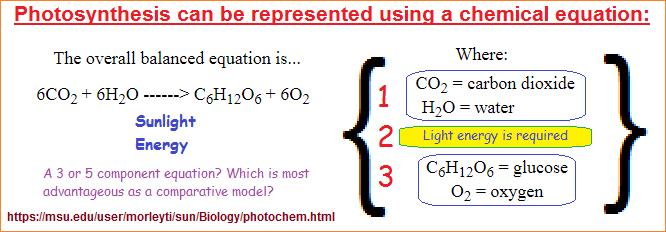
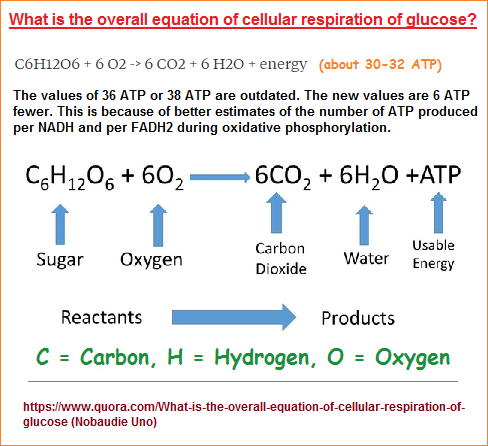
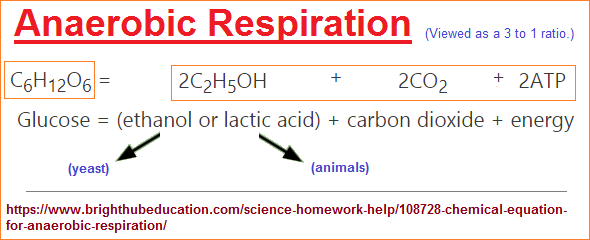
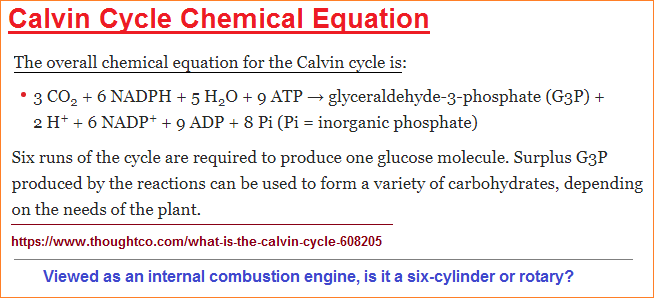
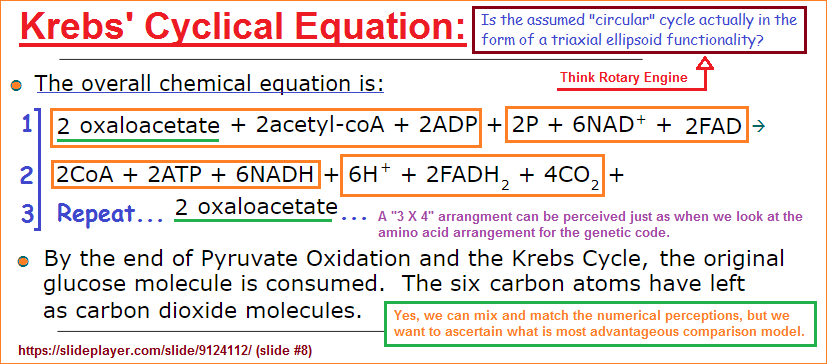
There are no large number values being used. This same "preoccupation" with low number values is seen in our ideologies and expressions. No matter what reason, excuse, or rationalization you may want to apply in accepting the occurrence, it is a tell-tale sign of an environmental imposition. In other words, while we can think in larger number groupings when asked to do so, we do not customarily engage in such behavior. We engage in recurring themes of low number value uses just as we see taking place in the equations of biological processes.
Let us take another look at some of the above examples coupled to a few others as a review emphasis about the low number values attached to individual atoms and the interactions:
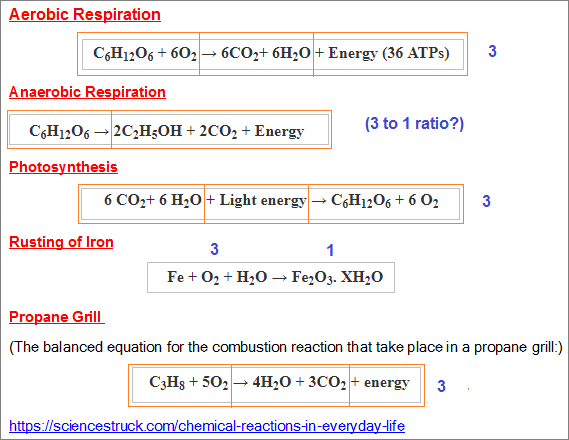 Chemical Reactions in Everyday Life 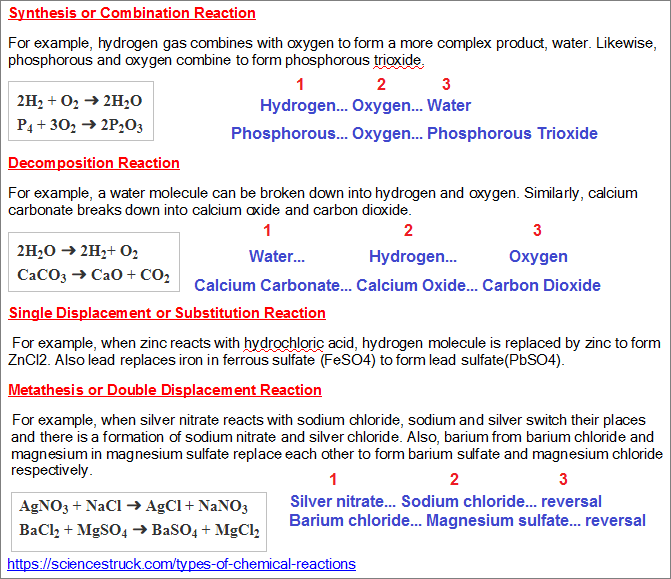 Vital Information About the Various Types of Chemical Reactions 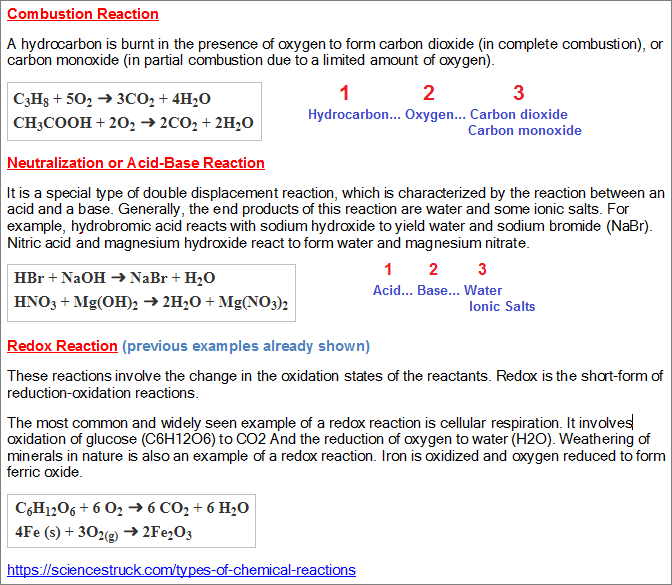 Vital Information About the Various Types of Chemical Reactions |
The above equations represent constrained repetitions which when looked at from a larger database of information from other subjects, reveals a recurring similarity that presents us with the situation we are dealing with a closed system in which equilibrium/homeostasis is not only permitted, but expected and prohibited to transgress... as well as being forced to accommodate along the course of either expansion or reduction such as might be described as evolutionary progress and deterioration. Transgressions, perhaps you might want to label them exceptions or mutations from the standard rules-of-thumb occurring in life at the present time, does not mean such exceptions or mutations will or will not become more widespread later on as the conditions of Earth change. In fact, subtle changes in these equations may well indicate some process is undergoing change that we humans should be concerned with or even assist with the development there of. In other words, if the numbers change we are given an indication of changes taking place on a subtle... if not overt level of recognition. However, we humans are often much too complacent, often take things for granted, and are not vigilant enough to detect alterations which may very will signal a changing constant, or a constant intermittancy. Such changes may possibly be overlooked by researchers dismissing them as flukes, incongruities, experimental issues, anomalies... or otherwise defining them as being irrelevant. We should be more attentive to cataloging and making note of differences just as we do to other environmental and biological phenomena and not simply call them part of a "range" of occurrences like some medical statistic shrugged off and labeled a personal quirk or person's own normalcy... like a bowel movement regularity.
Here's a list of the chemical formulas for some vitamins from the (U.S. National Library of Medicine). Please keep in mind the consideration that vitamins are a later born addition to the history of molecular substances:
| Vitamin | Molecular formula | Alternate name |
|---|---|---|
| A | C20H30O | Beta-carotene, etc... |
| B-1 | C12H17N4OS | Thiamine, etc... |
| B-2 | C17H20N4O6 | Riboflavin, etc... |
| B-3 | C6H5(6)NO2 | Niacin, etc... |
| B-5 | C9H17NO5 | Pantothenic Acid, etc... |
| B-6 | C8H11NO3 | Pyridoxine, etc... |
| B-7 | C10H16N2O3S | Biotin, etc... |
| B-9 | C19H19N7O6 | Folic Acid, etc... |
| B-12 | C63H88CoN14O14P | Cyanocobalamin, etc... |
| C | C6H8NO6 | Ascorbic Acid, etc... |
| D-2 | C28H44O | Ergocalciferol, etc... |
| D-3 | C27H44O | Cholecalciferol, etc... |
| E | C29H50O2 | Alpha-Tocopherol, etc... |
| K | C31H46O2 | Phylloquinone, etc... |
For those unfamiliar with vitamins and why so many people supplement everyday with, here is a list:
Source: Institute of Medicine - Food and Nutrition Board In humans there are 13 vitamins: 4 fat-soluble (A, D, E and K) and 9 water-soluble (vitamin C and 8 B vitamins)
|
With respect to the various minerals many people supplement their diets with, since there is no molecular formula per se as was described by the vitamins, we would have to turn to atomic structure in order to get some numerical values. However, though we may be inclined to think of them as being fundamental, a bit of thought will have to be imparted in this direction since the contemplation of what is and is not fundamental... since the inception of the Earth after the inception of the Sun... after the inception of the Universe... (thinking retrogradively); I will exclude such values for the time being. Yet, I will provide some information on the minerals taken from Harvard Medical School Listing of Vitamins:
|
|
|
|
|
|
|
| CALCIUM | Builds and protects bones and teeth. Helps with muscle contractions and relaxation, blood clotting, and nerve impulse transmission. Plays a role in hormone secretion and enzyme activation. Helps maintain healthy blood pressure | 31-50: M: 1,000 mg, W: 1,000 mg 51-70: M: 1,000 mg, W: 1,200 mg, 71+: M: 1,200 mg, W: 1,200 mg | 2,500 mg | Yogurt, cheese, milk, tofu, sardines, salmon, fortified juices, leafy green vegetables, such as broccoli and kale (but not spinach or Swiss chard, which have binders that lessen absorption) | Adults absorb roughly 30% of calcium ingested, but this can vary depending on the source. Diets very high in calcium may increase the risk of prostate cancer. |
| CHLORIDE | Balances fluids in the body. A component of stomach acid, essential to digestion | 14-50: M/W: 2.3 g, 51-70 M/W: 2.0 g, 71+: M/W: 1.8 g | Not known | Salt (sodium chloride), soy sauce, processed foods | New recommendations (DRIs) for chloride are under development by the Institute of Medicine. |
| CHROMIUM | Enhances the activity of insulin, helps maintain normal blood glucose levels, and is needed to free energy from glucose | 14-50: M: 35 mcg, 14-18: W: 24 mcg 19-50: W: 25 mcg 51+: M: 30 mcg, W: 20 mcg | Not known | Meat, poultry, fish, eggs, potatoes, some cereals, nuts, cheese | Unrefined foods such as brewer's yeast, nuts, and cheeses are the best sources of chromium, but brewer's yeast can sometimes cause bloating and nausea, so you may choose to get chromium from other food sources. |
| COPPER | Plays an important role in iron metabolism and immune system. Helps make red blood cells | M: 900 mcg, W: 900 mcg | 10,000 mcg | Liver, shellfish, nuts, seeds, whole-grain products, beans, prunes, cocoa, black pepper | More than half of the copper in foods is absorbed. |
| FLUORIDE | Encourages strong bone formation. Keeps dental cavities from starting or worsening | M: 4 mg, W: 3 mg | 10 mg | Water that is fluoridated, toothpaste with fluoride, marine fish, teas | Harmful to children in excessive amounts. |
| IODINE | Part of thyroid hormone, which helps set body temperature and influences nerve and muscle function, reproduction, and growth. Prevents goiter and a congenital thyroid disorder | M: 150 mcg, W: 150 mcg | 1,100 mcg | Iodized salt, processed foods, seafood | To prevent iodine deficiencies, some countries add iodine to salt, bread, or drinking water. |
| IRON | Helps hemoglobin in red blood cells and myoglobin in muscle cells ferry oxygen throughout the body. Needed for chemical reactions in the body and for making amino acids, collagen, neurotransmitters, and hormones | 19-50: M: 8 mg, W: 18 mg 51+: M: 8 mg, W: 8 mg | 45 mg | Red meat, poultry, eggs, fruits, green vegetables, fortified bread and grain products | Many women of childbearing age don't get enough iron. Women who do not menstruate probably need the same amount of iron as men. Because iron is harder to absorb from plants, experts suggest vegetarians get twice the recommended amount (assuming the source is food). |
| MAGNESIUM | Needed for many chemical reactions in the body Works with calcium in muscle contraction, blood clotting, and regulation of blood pressure. Helps build bones and teeth | 18+: M: 420 mg, W: 320 mg | 350 mg (Note: This upper limit applies to supplements and medicines, such as laxatives, not to dietary magnesium.) | Green vegetables such as spinach and broccoli, legumes, cashews, sunflower seeds and other seeds, halibut, whole-wheat bread, milk | The majority of magnesium in the body is found in bones. If your blood levels are low, your body may tap into these reserves to correct the problem. |
| MANGANESE | Helps form bones. Helps metabolize amino acids, cholesterol, and carbohydrates | M: 2.3 mg, W: 1.8 mg | 11 mg | Fish, nuts, legumes, whole grains, tea | If you take supplements or have manganese in your drinking water, be careful not to exceed the upper limit. Those with liver damage or whose diets supply abundant manganese should be especially vigilant. |
| MOLYBDENUM | Part of several enzymes, one of which helps ward off a form of severe neurological damage in infants that can lead to early death | M: 45 mcg, W: 45 mcg | 2,000 mcg | Legumes, nuts, grain products, milk | Molybdenum deficiencies are rare. |
| PHOSPHORUS | Helps build and protect bones and teeth. Part of DNA and RNA. Helps convert food into energy. Part of phospholipids, which carry lipids in blood and help shuttle nutrients into and out of cells | M: 700 mg, W: 700 mg | 31-70: 4,000 mg 71+: 3,000 mg | Wide variety of foods, including milk and dairy products, meat, fish, poultry, eggs, liver, green peas, broccoli, potatoes, almonds | Certain drugs bind with phosphorus, making it unavailable and causing bone loss, weakness, and pain. |
| POTASSIUM | Balances fluids in the body. Helps maintain steady heartbeat and send nerve impulses. Needed for muscle contractions. A diet rich in potassium seems to lower blood pressure. Getting enough potassium from your diet may benefit bones | M: 4.7 g, W: 4.7 g | Not known | Meat, milk, fruits, vegetables, grains, legumes | Food sources do not cause toxicity, but high-dose supplements might. |
| SELENIUM | Acts as an antioxidant, neutralizing unstable molecules that can damage cells. Helps regulate thyroid hormone activity | M: 55 mcg, W: 55 mcg | 400 mcg | Organ meats, seafood, walnuts, sometimes plants (depends on soil content), grain products | Researchers are investigating whether selenium may help reduce the risk of developing cancer, but with mixed results. |
| SODIUM | Balances fluids in the body. Helps send nerve impulses. Needed for muscle contractions. Impacts blood pressure; even modest reductions in salt consumption can lower blood pressure | M: 2,300 mg, W: 2,300 mg | Not determined | Salt, soy sauce, processed foods, vegetables | While experts recommend that people limit sodium intake to 2,300 mg, most Americans consume 4,000-6,000 mg a day. |
| SULFUR | Helps form bridges that shape and stabilize some protein structures. Needed for healthy hair, skin, and nails | Unknown | Unknown | Protein-rich foods, such as meats, fish, poultry, nuts, legumes | Sulfur is a component of thiamin and certain amino acids. There is no recommended amount for sulfur. Deficiencies occur only with a severe lack of protein. |
| ZINC | Helps form many enzymes and proteins and create new cells. Frees vitamin A from storage in the liver. Needed for immune system, taste, smell, and wound healing. When taken with certain antioxidants, zinc may delay the progression of age-related macular degeneration | M: 11 mg, W: 8 mg | 40 mg | Red meat, poultry, oysters and some other seafood, fortified cereals, beans, nuts | Because vegetarians absorb less zinc, experts suggest that they get twice the recommended requirement of zinc from plant foods. |
| *Recommended dietary allowance **Adequate intake | |||||
Disclaimer: | |||||
And let us not forget to describe some common sugars:
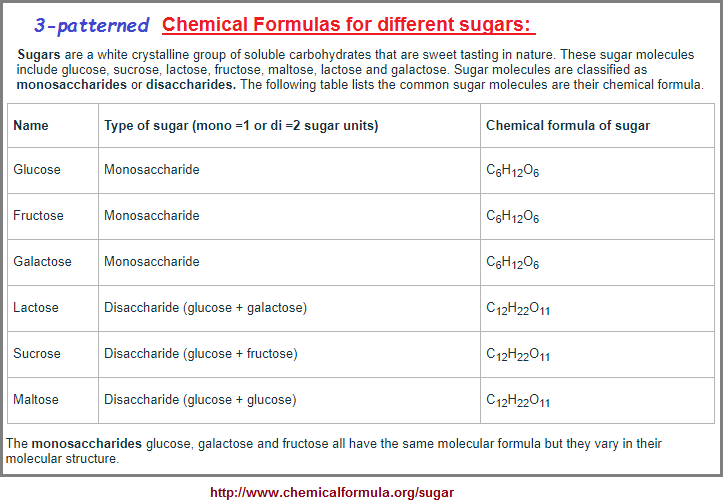
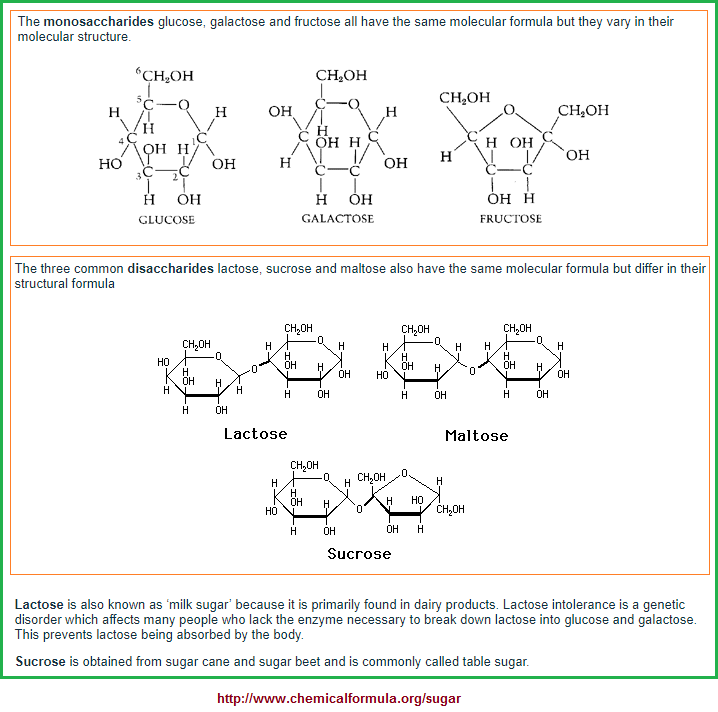
Chemical Formula
And how about let's provide some formulas for everyday goods well-known to many people:
US National Library of Medicine
- Caffeine: C8H10N4O2
- Nicotine: C10H14N2
- Tea: (Camellia sinensis extract)- C50H50N4O26
Origination date: Tuesday, June 25, 2019... 4:41 AM
Initial Posting: Friday, August 30, 2019... 8:53 AM
Updated Posting: Tuesday, January 17, 2023... 11:51 AM
Herb O. Buckland
herbobuckland@hotmail.com